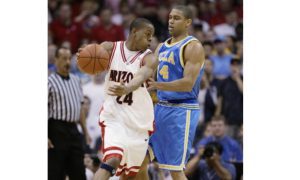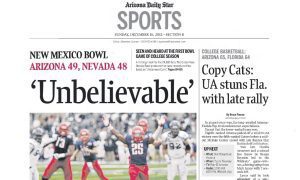“Lute Olson wasn’t stubborn like Sean Miller.”
“I remember when people said Lute Olson couldn’t coach a lick after he got here. Look at him now. People are saying the same thing now about Sean Miller.”
These were comments heard on Tucson’s sports radio station Wildcats Sports Radio 1290-AM after Arizona was eliminated in the first round of the NCAA tournament by Buffalo last week.
Miller knew when he took the Arizona job in 2009 that comparisons with Olson would happen, right or wrong. The act he had to follow included four Final Four appearances and a national championship in 1997.
Miller also took over a program at the time that had not advanced to the Final Four in seven years, and was one that had two interim coaches in as many years before his arrival.

Sean Miller and Lute Olson during the filming of a Hughes Federal Credit Union commercial a few years ago
The “stubborn” comment comes from Miller sticking to his man-to-man pack line defense despite a declining performance this season. Miller rarely if ever has applied a zone defense to mask on-the-ball defensive deficiencies of his team.
When Olson arrived from Iowa in 1983, he also was a primarily a man-to-man defensive coach. But he soon realized that matchup zones and 1-3-1 alignments, along with the man-to-man, kept opponents off balance.
Olson went from a shorter and thinner, yet tough and talented frontline (Anthony Cook, Tom Tolbert and Sean Elliott) to the Tucson Skyline (Sean Rooks, Brian Williams and Ed Stokes).
After exposed by overwhelming guard play in NCAA tournament first round losses to Santa Clara and East Tennessee State, Olson then adapted more of a style predicated for talented point guards, creating the “Point Guard U” aura that included Damon Stoudamire, Reggie Geary, Mike Bibby, Jason Terry and Jason Gardner.
These guards had talented backcourt mates such as Khalid Reeves, Miles Simon and Gilbert Arenas. The idea of “The Tucson Skyline” became a novelty.
The bottom line is Olson made changes in his coaching philosophy both strategically and with his personnel.
Many Arizona fans view Miller sticking to his guns coaching his man-to-man defense and drawing various five-star recruits without a clear-cut plan to put the puzzle together. After all, to reload every year with a growing number of one-and-done or two-and-done players leaving, you take what you can get and try to build chemistry as you go.
Olson never had to endure the brunt of the one-and-done era. Most of his standouts lasted four years, save for Bibby, Arenas and Andre Iguodala, each of whom left after two years, and three-year standouts Michael Wright, Richard Jefferson and Williams. Overall, Olson had much more continuity with his personnel because of the time in which he coached.
Olson was questioned by some, including Syracuse’s Jim Boeheim, when he said he would not recruit one-and-done players after Jerryd Bayless left after one year following Olson’s first year of a leave absence in 2007-08.
Olson never had to tame the monster of one-and-done recruitment because he retired for good after his second year of the leave of absence in 2008-09, the season before Miller arrived.
Miller’s first one-and-done player was not until Grant Jerrett in 2013. He has coached at least one such talent every year but one since — Aaron Gordon (2014), Stanley Johnson (2015), Lauri Markkanen (2017) and Deandre Ayton this year.
Olson said he would not recruit one-and-done players, but would he have sat back and watched Mike Krzyzewski and Steve Alford take advantage of such talent and not do anything about it?
In terms of the claim that fans said “Olson couldn’t coach a lick,” the primary criticism from the Arizona faithful before Olson’s first Final Four trip in 1988 was that Olson did not motivate his players properly come March. Arizona lost in first round games in 1985, 1986 and 1987 before the historic run in 1988.
The first-round flameouts against Santa Clara, East Tennessee State and Miami (Ohio) in the early 1990’s also caused an uproar but those losses were sandwiched between Final Four appearances.
Olson mentioned in the few years after his hire in 1983 that players should motivate themselves, that it was not his responsibility to create a fire within his players. Some fans took him to task on those words, but Olson’s philosophy eventually took its course with headstrong players such as Steve Kerr, Elliott, Stoudamire, Geary, and so on.
Olson earned his first Final Four trip five years into his tenure at Arizona. Miller just completed his ninth season without making it that far — yet another comparison — amid off-court turmoil with the arrest of long-time assistant coach Book Richardson by the FBI on a federal bribery, corruption, conspiracy and fraud charges.
The full extent of the FBI investigation is unknown. Miller faced late-season scrutiny with an ESPN story alleging he talked on an FBI wiretap to agent runner Christian Dawkins about a $100,000 payment to secure the services of Ayton, a claim Miller vehemently denies.
How all this ties into potential NCAA sanctions down the road is also uncertain at this point.
The off-the-court controversies Olson endured included two overtures by Kentucky that he turned down during his tenure, the Khalid Reeves alleged rape incident of a 23-year-old female student (in which Tucson law authorities did not prosecute him) and the welcoming of Chris Mills from Kentucky after Mills was barred from playing for the Lexington school following an alleged payment from Kentucky assistant Dwayne Casey to Mills’ father.
Olson did not think twice of allowing Mills into the program despite that cloud. He may have been chided by opposing fans but Olson did not face overwhelming media objection with the move.
I can’t compare eras in Arizona hoops without discussing the great Bob Elliott not having his jersey retired along with Sean Elliott (no relation), Kerr, Bibby, Terry and Gardner.
Bob Elliott was not a national player of the year award winner — a requirement for the honor — you say?
Well, did Bob Elliott have the visibility in the early- to mid-1970s that players of this generation have today with social media, ESPN, FS1, etc.? If he did, it would be a different story.
One of only 111 college players with at least 2,000 points and 1,000 rebounds in a career, Bob Elliott would certainly be discussed among the elite players in the country with the means of notoriety that are prevalent today, instead of being somewhat of an obscure talent playing in the WAC back then.
Comparing today with yesterday has a way of opening the eyes.
FOLLOW @JAVIERJMORALES ON TWITTER!
ALLSPORTSTUCSON.com publisher, writer and editor Javier Morales is a former Arizona Press Club award winner. He is a former Arizona Daily Star beat reporter for the Arizona basketball team, including when the Wildcats won the 1996-97 NCAA title. He has also written articles for CollegeAD.com, Bleacher Report, Lindy’s Sports, TucsonCitizen.com, The Arizona Republic, Sporting News and Baseball America, among many other publications. He has also authored the book “The Highest Form of Living”, which is available at Amazon.


















